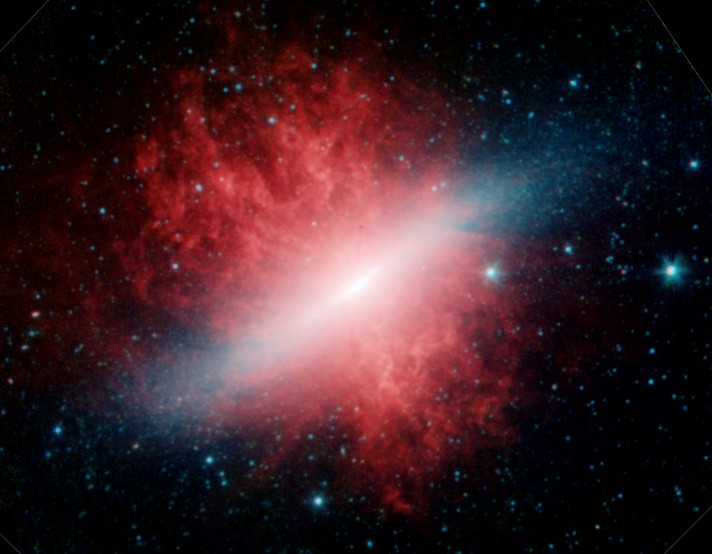
|
Explanation: Very bright in infrared light, well-known starburst galaxy M82's popular name describes its suggestive shape seen at visible wavelengths - The Cigar Galaxy. Ironically, M82's fantastic appearance in this Spitzer Space Telescope image really is due to cosmic "smoke" - the infrared emission of exented dust features blown by stellar winds from M82's luminous, central star forming regions. The false-color view highlights a component of dust emission from complex carbon molecules called polycyclic aromatic hydrocarbons or PAHs. PAHs are also seen in star forming regions throughout our own, much calmer, Milky Way Galaxy and are products of combustion on planet Earth. Likely triggered by interactions with nearby galaxy M81, M82's intense star formation activity appears to be blowing out immense clouds of dust and PAHs extending nearly 20,000 light-years both above and below the galactic plane. M82 is about 12 million light-years away in the constellation Ursa Major.
|
January February March April May June July August September October November December |
| ||||||||||||||||||||||||||||||||||||||||||||||||
NASA Web Site Statements, Warnings, and Disclaimers
NASA Official: Jay Norris. Specific rights apply.
A service of: LHEA at NASA / GSFC
& Michigan Tech. U.
Based on Astronomy Picture
Of the Day
Publications with keywords: dust - infrared - star formation - M 82
Publications with words: dust - infrared - star formation - M 82
See also:
- APOD: 2025 August 28 B Galaxies, Stars, and Dust
- APOD: 2025 July 10 B Lynds Dark Nebula 1251
- APOD: 2025 June 23 B W5: Pillars of Star Formation
- APOD: 2025 May 7 B Galaxy Wars: M81 versus M82
- APOD: 2025 April 28 B Gum 37 and the Southern Tadpoles
- 38 Hours in the M81 Group
- APOD: 2025 March 26 B Star Formation in the Pacman Nebula
